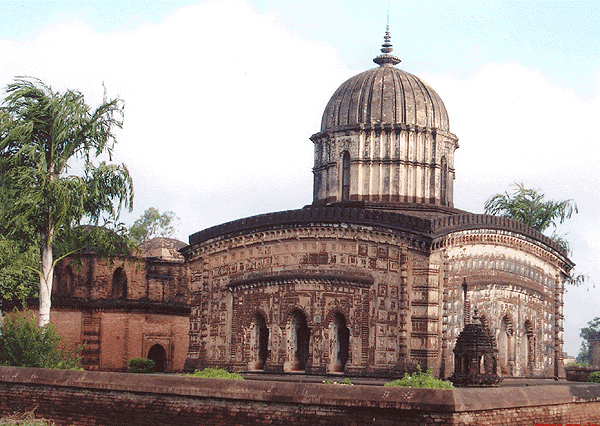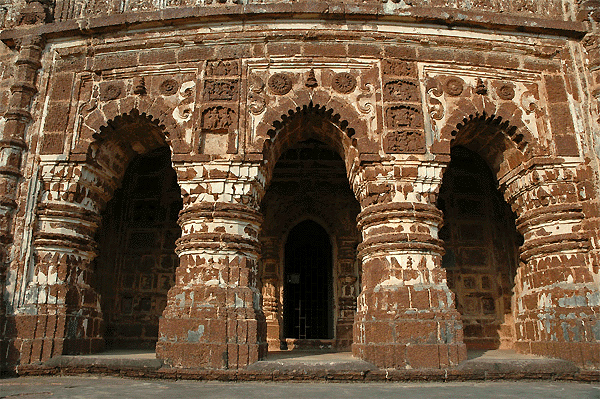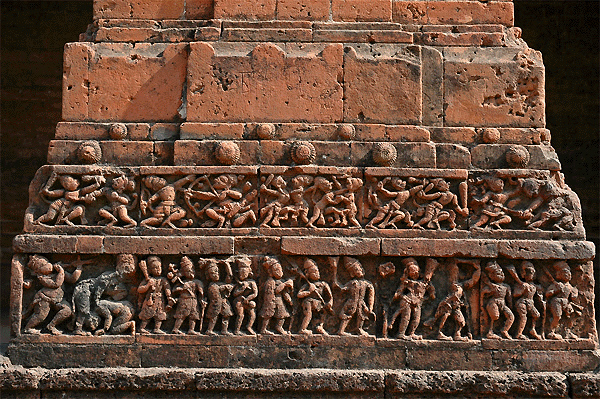The Beauty of Bengali Temples - Part 2
BY: SUN STAFF

Radha Shyam Mandir, Bishnupur
Sep 29, CANADA (SUN) — In a philosophy discussion on the Evolutionists, Srila Prabhupada discussed the material elements, using the process of building with bricks to make his point:
"Of these five elements. Especially earth, water and fire. Just like this brick What is this brick? Earth, water, mix and put it into fire. It is brick. [ ] And you crush this brick, it becomes mortar. And mix with lime and water. Then it becomes cementing plaster, and put the bricks after bricks with that cement and it becomes house. So ultimately earth, water, and fire. Tejo-vari-mrdam vinimayam, exchange of earth, water, and fire."
On a morning walk in Mayapur, Srila Prabhupada once discussed the building of the Mayapur temple structure. He instructed the devotees to build in a traditional manner, using brick and mortar on a slab. He said cement was alright, but no iron rebar was to be used.
In both of these references, Srila Prabhupada is alluding to a building process quite similar to that used to erect the brick and terracotta temples of West Bengal.
In his book "Temples and Legends of Bengal", which is excerpted below, author P.C. Roy Choudhury describes the architecture, culture and mood situated around many of West Bengal's most prominent temples.

Jor-Mandir Temples
"Temples of baked mud bricks are a particular feature in Bengal. The deft fingered potters in various parts of Bengal like Bankura, Krishnanagar etc., turn out fine specimens of pottery pieces, many of which are now exported, to foreign countries. Their handiwork is also seen in the superb images of deities they make. Large temples of various types were constructed entirely out of baked clay mud-bricks by the masons. They are indigenous to Bengal.
Exquisite sculpture of [lila pastime] scenes and illustrations of current events and trends on the walls, jambs or the panels and sculptured pillars are some of the remarkable features of these temples. Many of these temples of mud-bricks were built from the sixteenth to the eighteenth century. Most of them have now been decaying mainly through neglect and age. There are still a few, which stand out as splendid specimens of the type.
The very fine ornamentation on the clay walls and pillars of the Jor-Bangla temple at Bistupur wins the admiration of every one who has seen it. Various Pauranik scenes and phases of Krishna Lila have been wonderfully reproduced on the walls and pillars. Terracotta art had attained a very high incidence of excellence.
There has also been the use of laterite stones in building some temples and the temple of Gokul Chand at Saldah village in Bankura district is a unique specimen. This temple is of Pancha ratna type and has five turrets. Although almost dilapidated and in the midst of snake-infested bushes and jungles, the temple is well worth a visit to appreciate the high skill in paneling work. Some of the Rekha deul temples showing a clear impact of Orissa type of temples are also fine specimens of sculpture. Bengal potters and stone masons are well known for their delicate execution of image work. There is no reason to think that the images and particularly the old ones were ever imported. Some of the temples in Bankura district amply prove that the masons could execute absolutely different types of temples.

Jor-Mandir Architecture
In the British times the nomenclature of many places got anglicized. Thus Mathura became Muttra, Varanasi was Benaras and Kalikata became Calcutta. In the same manner Burdwan was substituted for Bardhaman. Bardhaman or Burdwan, historically a very important district from before the British days, adjoins the Santal Paragons and Dhanbad districts in Bihar and Purulia, Bankura, Hooghly, Nadia, Murshidabad and Birbhum districts in Bengal.
The district of Hooghly has the district of Burdwan on the north, the river Hooghly on the east, the district of Howrah on the south and the districts of Midnapore, Bankura and Burdwan on the west. Hooghly district is mainly the product of its rivers. The three large rivers, the Hooghly, the Damodar and the Dwarkeswar, with their extensive and violent oscillations have determined the physiography of the district and have given rise to the smaller streams.
The district of 24 Parganas adjoins Calcutta and covers an ancient area. Large number of very old bricks and pieces of pottery, rectangular copper coins and terra cotta have been found which definitely suggest the possibility of more early antiquities if excavations are done. The area was under the reputed Maharaja Pratapaditya of Jessore. There are a number of villages now in decadence but which obviously had once seen prosperous days. A rapid view of some of these villages will be some interest.

Madan Mohan Temple
The cult of Saivism has a deep hold on Bengal. Temples dedicated to Lord Siva are very common. Almost every village in Bengal has Saivaities, Shaktas and Vaishnavas, but the number of Siva temples is by far the largest. Even when Bengal was caught and swept over by the very strong current of Vaishnavism, the worship of Siva and Sakti had not disappeared.
The image of Lord Siva that Vivandaka Rishi worshipped and obtained Siddhi (Salvation) is now known as Siddhinath or Vandeshwar, which is Birsinghapur. This is one of the Anadi lingams. Ramayan mentions Vivandaka Rishi. The ancient Bengali literature has delineation of Siva and his consort Parvati in prose, poetry, ballads, stories and songs."

Lord Brahma, Bishnupur Temple Detail
In tomorrow's final series chapter, we'll present a list of nearly fifty of West Bengal's finest temples, including Vaisnava, Shaivite and Shakti examples of architectural design.
